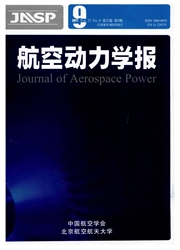

 中文摘要:
中文摘要:
使用自行研制的高速飞行器瞬态气动热试验模拟系统,对金属蜂窝板结构在多种瞬态热冲击速率下(5℃/s至30℃/s)的隔热特性进行了试验研究,其中最高瞬时温度达到950℃.并采用三维有限元方法对金属蜂窝板结构在高速热冲击环境下的隔热特性进行了数值计算,其计算结果与试验结果吻合性良好,验证了试验方法以及数值模拟方法的可信性和有效性.由试验知金属蜂窝板结构经过950℃热冲击后的翘曲和扭曲变形均很小,特别适合用于制作在高温环境下,要求变形小、质量少的高速飞行器结构部件.
 英文摘要:
英文摘要:
By using a self-developed transient aerodynamic thermal simulation system of high-speed aircraft, the heat-shielding performance of metallic honeycomb panel structure was tested at different transient thermal shock rates ranging from 5 ℃/s to 30℃/s, with the maximum instantaneous temperature reaching 950 ℃. Furthermore, a three-dimensional finite element method was established to determine the heat-shielding performance of the metallic honeycomb panel structure at different simulation environments with high thermal shock rates. The numerical calculation results coincide with the corresponding experimental results, verifying the credibility and effectiveness of the experimental methods and the numerical calculation approach. The tested metallic honeycomb panel structure exhibited slight planar flexure and deformation after the experiment in the high-temperature (950 ℃) environment; thus, in the context of high-speed flight vehicles, this structure is particularly suitable for structural components that must be made of lightweight materials with slight deformation in a high-temperature environment.
 同期刊论文项目
同期刊论文项目
 同项目期刊论文
同项目期刊论文
 High-accuracy two-dimensional digital image correlation measurement system using a bilateral telecen
High-accuracy two-dimensional digital image correlation measurement system using a bilateral telecen Strain measurement of objects subjected to aerodynamic heating using digital image correlation: Expe
Strain measurement of objects subjected to aerodynamic heating using digital image correlation: Expe High-speed and accurate non-linear calibration of temperature sensors for transient aerodynamic heat
High-speed and accurate non-linear calibration of temperature sensors for transient aerodynamic heat Experimental study and numerical simulation of active vibration control of a highly flexible beam us
Experimental study and numerical simulation of active vibration control of a highly flexible beam us Experimental and numerical study on heat transfer characteristics of metallic honeycomb core structu
Experimental and numerical study on heat transfer characteristics of metallic honeycomb core structu Experimentalresearch on thermal insulation performance of lightweight ceramic material inoxidation e
Experimentalresearch on thermal insulation performance of lightweight ceramic material inoxidation e Thermalprotection performance of metallic honeycomb core panel structures innon-steady thermal envir
Thermalprotection performance of metallic honeycomb core panel structures innon-steady thermal envir Optimizationof a three-dimensional digital image correlation system for deformationmeasurement in ex
Optimizationof a three-dimensional digital image correlation system for deformationmeasurement in ex High-temperature strain measurement using active imaging digital image correlation and infrared radi
High-temperature strain measurement using active imaging digital image correlation and infrared radi Insulation Performance of Heat-Resistant Material for High-Speed Aircraft Under Thermal Environments
Insulation Performance of Heat-Resistant Material for High-Speed Aircraft Under Thermal Environments Accurate ex situ deformation measurement using an ultra-stable two-dimensional digital image correla
Accurate ex situ deformation measurement using an ultra-stable two-dimensional digital image correla 期刊信息
期刊信息
